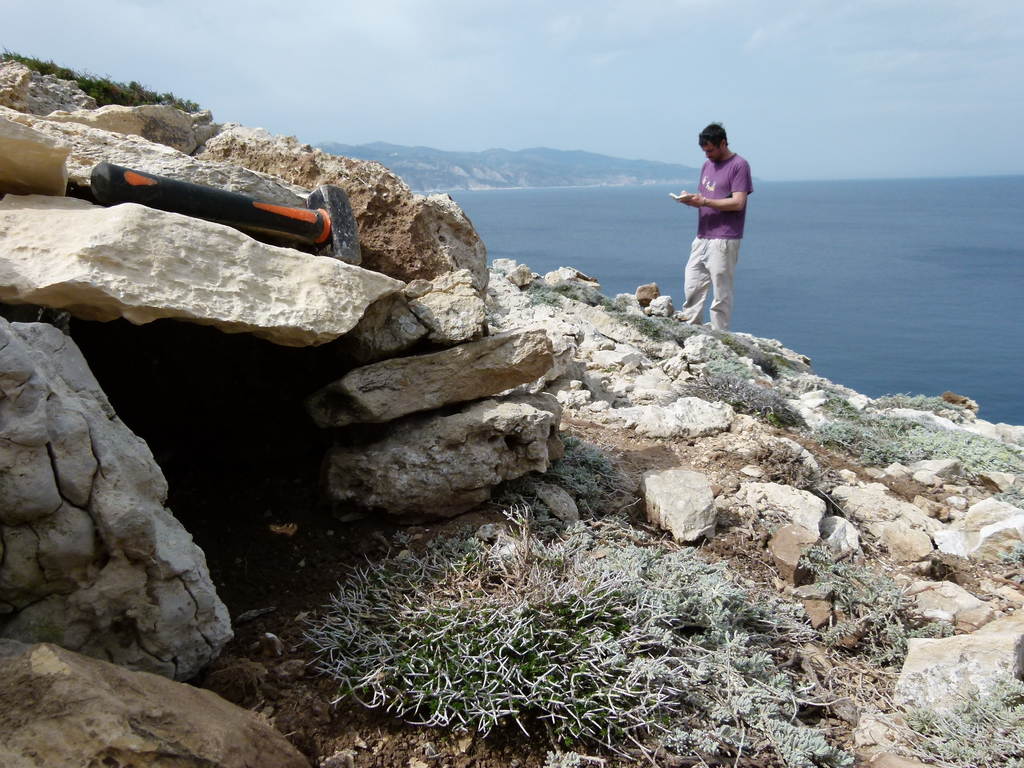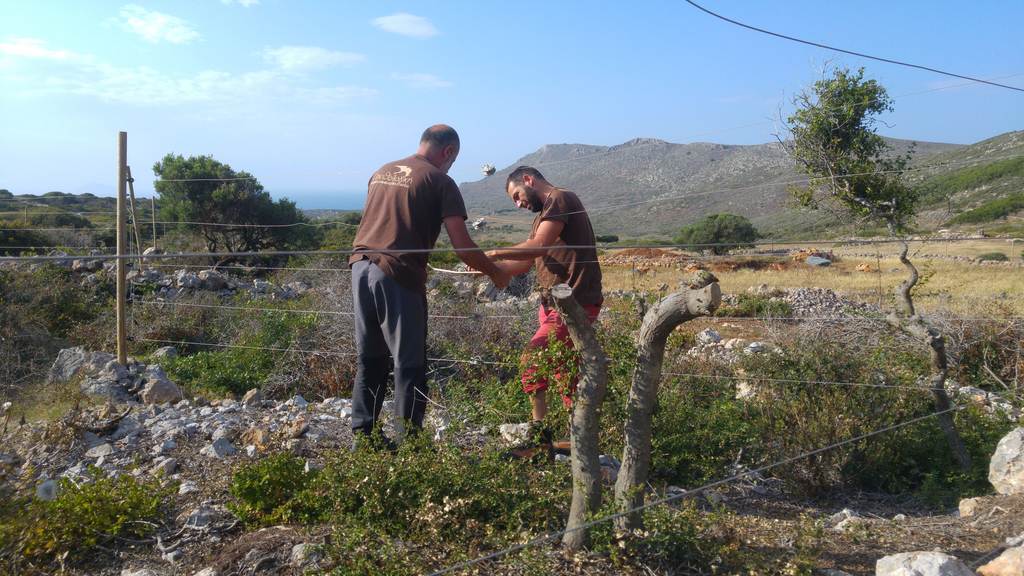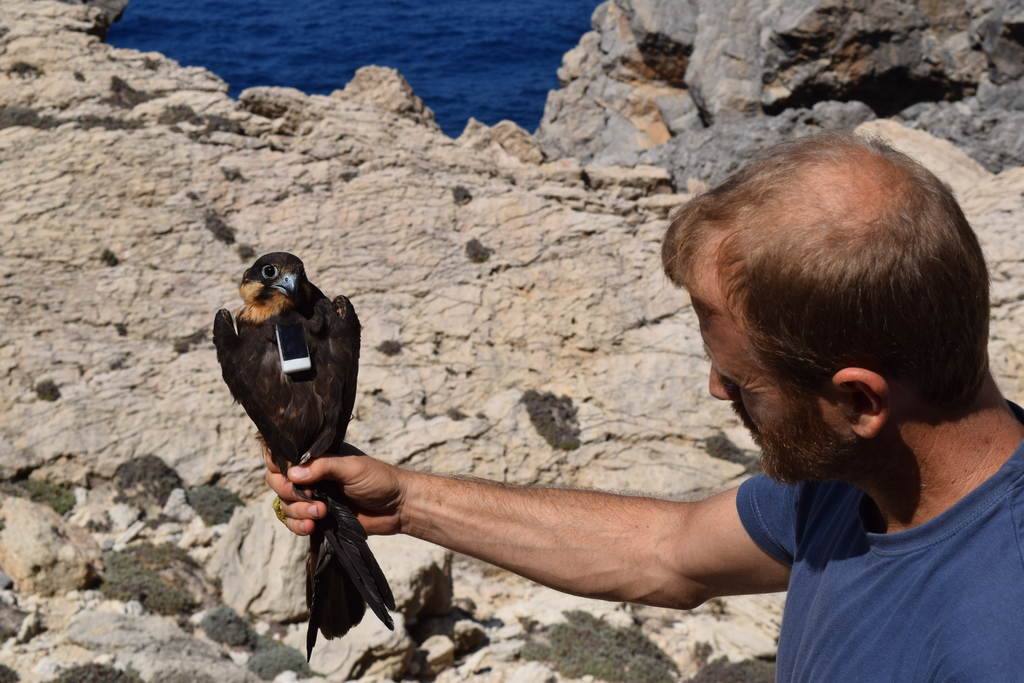March 2019 - LIFE ElClimA
Α) Identity of the project
| Title/ N° |
Conservation measures to assist the adaptation of Falco eleonorae* to climate change - LIFE ElClimA |
| Duration |
01/08/2014 – 30/09/2019 |
| Budget |
Total budget: 1,206,201.00 € EU Contribution: 898,632.00 € |
|
Beneficiaries |
Coordinator: University of Patras – Special Account for Research Funds Partners: Hellenic Ornithological Society Nature Conservation Consultants ΝCC Ltd |
| Location of activities |
Aegean Sea (Skyros, Limnos, Makares, Tilos, Karpathos, Dionysades, Antikythira) |
| Website | |
| Contact |
Dr. Sinos Giokas, Associate Professor of Animal Biodiversity & Evolution |
Description/Aim
Eleonora’s falcon (Falco eleonorae) is a migratory raptor that is considered one of the most important bird species in the country, given that the islands of the Aegean Sea host more than 85% of its global breeding population.
According to the results of long term studies, mainly in colonies of the species in Greece, the status of Eleonora’s falcon populations depends largely on the quality of the habitats where it feeds and reproduces and the availability of food. Although classified as an insectivorous species, its breeding period is synchronized with the autumn flux of migratory passerines over the colonies constituting its main prey. Recently, there are indications of a northwards shift in the species distribution in the Aegean Sea, a pattern consistent with the predictions of the Climatic Atlas of the European Birds (Huntley et al. 2007). The reasons for this shift remain unclear, but are possibly related with (a) the constant raising of maximum summer air temperatures in the Eastern Mediterranean, affecting egg thermoregulation and leading to increased egg infertility, (b) the predation of eggs and nestlings by rats in colony islets and (c) a possible mismatch of Eleonora’s falcon breeding period with the changing passerine migratory flux over its colonies.
The LIFE ElClimA project aims to facilitate the species’ adaptation to the ongoing and future climate change by the implementation of a series of conservation actions.
Specifically, the objectives of the program relate to:
- the improvement of breeding performance of the species, by (a) reducing egg losses and mortality rates of nestlings (b) improving the quality and increasing the availability of nesting sites and (c) improving prey availability and quality.
- the improvement of the species’ conservation status at its foraging areas both within its breeding and wintering range by (a) identifying foraging areas utilized by the species, (b) assessing the quality and impact of land use in these areas, (c) networking among experts and organization of workshops to help design and promote efficient mitigation measures.
Β) Best Practices
Based on the projects’ results so far, it turns out that its actions are best practices for achievement of its goals and in particular consist of:
- installation of artificial nests for Eleonora’s falcons, which provide shelter from both high temperatures and extreme weather conditions, as well as the possible reduction of vegetation cover on the islets in the future,
- rat eradication on the islets where Eleonora’s falcons breed, which improves both the conservation status of the species and the ecosystem on the islet, enabling them to adapt better to any changes,
- creation of refueling oases for passerines on islands and islets, which increase food availability for the Eleonora’s falcons, while also improving the species conservation status and its ability to adapt to changes,
- use of telemetry methods for the identification and assessment of foraging and wintering sites of the species.
The experience gained from the implementation of the project concerning the implementation and effectiveness of the best practices, as well as the results of studies conducted for the improvement of existing knowledge for the species, will be presented in a Good Practice Guide (GPG) for the management of the Eleonora’s Falcon’s foraging grounds, as well as for the conservation and improvement of the species breeding, wintering and stopover habitats.
The combination of on the field actions with simultaneous information of the local community and raising awareness on subjects that are of interest is a good practice used in the framework of the project with notable results.
C) Results
To date the main project activities include:
- Update of the knowledge on the species’ population size and breeding performance within the project areas.
- Implementation of the largest rat eradication action on islets of the Aegean Sea. The results are already evident in the breeding success of Eleonora’s falcon, as well as in the recovery of the islets’ ecosystem. The action was implemented on islets totaling in an area of 700ha.
- Construction of 1,000 artificial nests in the species’ breeding colonies, of which 20-25% are already used by the birds.
- Assessment of the refueling pattern of migratory passerines.
- Creation of a refueling oasis for migratory birds on Antikythira, through the purchase of land (1ha). It is just the second land purchase for nature protection through a LIFE project in Greece, after the Sekania beach on Zakynthos.
- Identification and assessment of the species’ foraging grounds during the breeding and wintering period using telemetry technology.
The project results will be incorporated in the Good Practice Guide, which will be the most important dissemination tool of the experience gained to stakeholders. The stakeholders that could utilize the projects’ results are the Ministry of Environment and Energy centrally, as well as local Management Authorities of insular areas, Forestries and others and stakeholders of other Mediterranean countries that host the species. Best practices could thus be applicable for the species in other areas, as well as an example and trigger for their pilot implementation also for other species towards adaptation to climate change.
Until the end date of the project the deliverables of the concrete conservation and monitoring actions will be finalized, the After LIFE conservation plan for the species and the Good Practice Guide produced, with the latter being presented in an international conference. After the end of the project the monitoring and maintenance of infrastructure will continue, while actions will be carried out based on the After LIFE conservation plan.







